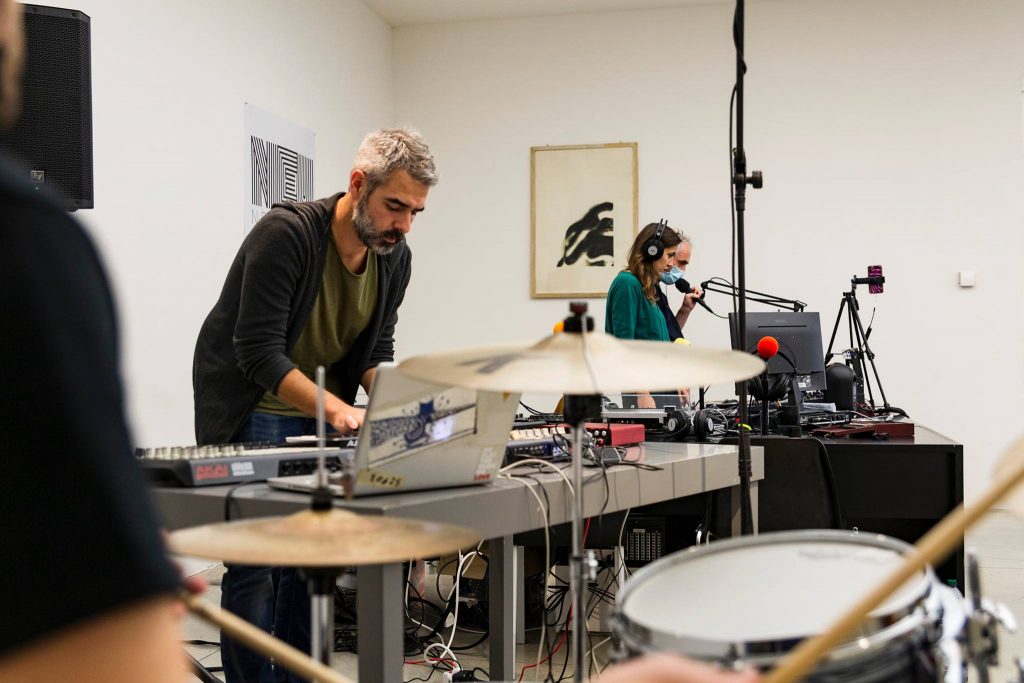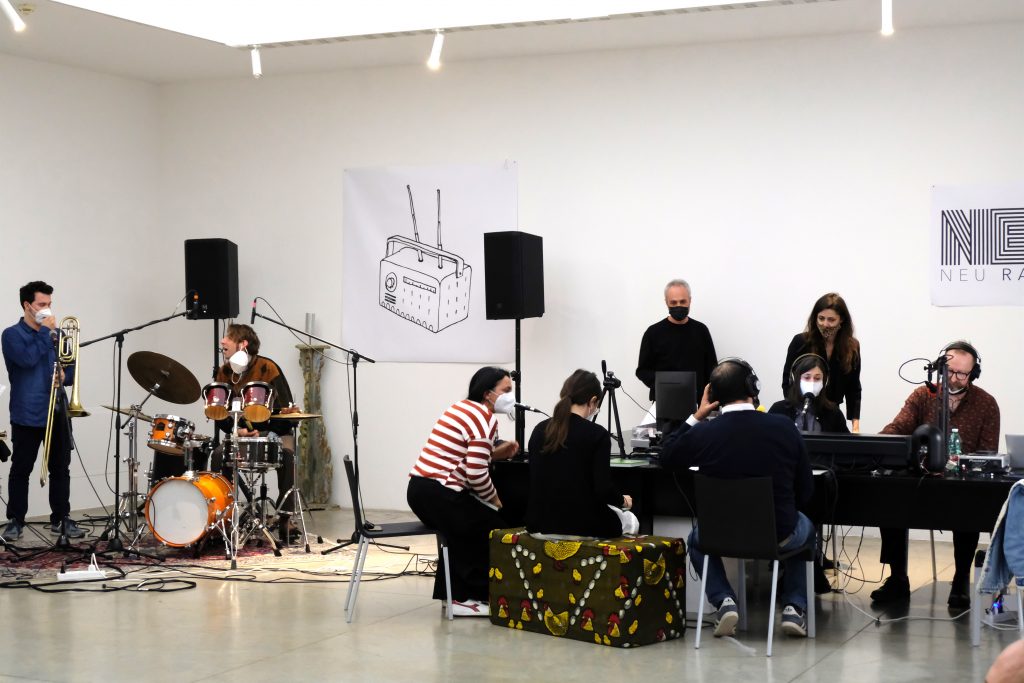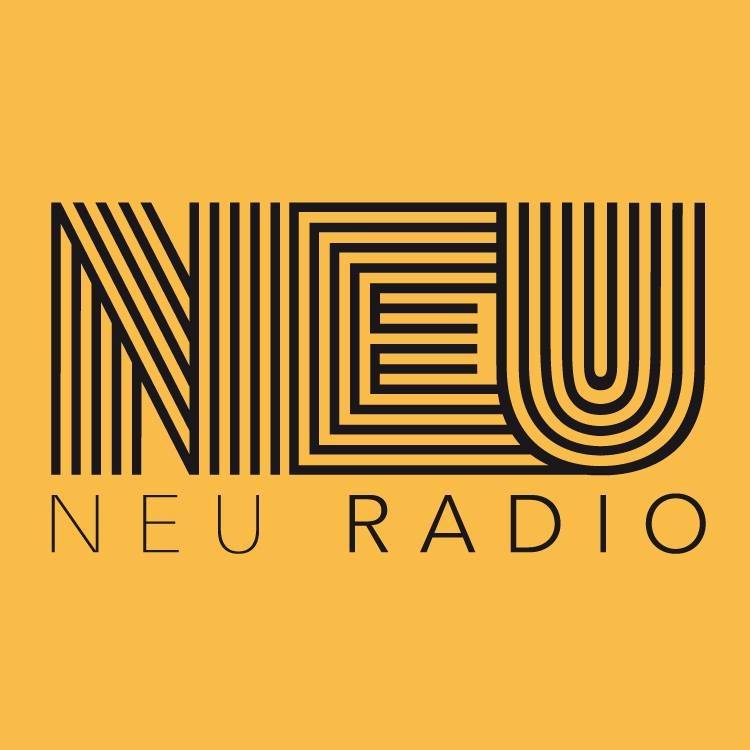NEU RADIO
Generazione Critica: How was NEU radio born and what were the forewords with Humus Associazione Culturale? What does it mean to give life to a radio in the 2000s? How did you approach the choice of being a digital radio?
NUE RADIO: NEU RADIO was born in 2018 in Bologna, founded by a group of about ten people reunited as a collective of radio authors and editors, coming from a common path on a historic city radio in FM. The goal was to pursue the promotion of free and independent radio culture, as an expression of that sense of collectivity that has always characterized our radio path. This is why NEU RADIO: a new radio, a radio in which the “we” was the bearer, a “we” made up of individuals united by the need and desire to catalyze creative forces and energies. A word game based on the ambiguity of the German pronunciation that also recalls a krautrock scenario: we liked it right away.
Over the years, radio has evolved, managing to gather other creative energies around it. Many other figures and personalities have joined the original group: DJs, music lovers, but also journalists and in general people with a great desire to share their knowledge in a free and transversal way. Currently we have about fifty broadcasts on air, and many people who collaborate on a weekly and monthly basis, contributing to a rich schedule: dozens and dozens of music broadcasts of the most disparate genres, but columns about art, comics, cultural insights into society, cinema, history and sport. All of this makes NEU RADIO truly unique.
With NEU RADIO we decided to explore the idea of an independent web radio that can be used at any time. Being few, we started with an audio magazine of limited monthly content. After a daily flow schedule, we soon felt the need and desire to increase the quantity of content, and a crowdfunding campaign allowed us to purchase the necessary equipment to move to streaming and set up a studio in the Baumhaus spaces at DLP, in Bolognina. Thanks to this, we have consolidated a series of relationships cultivated over time with realities similar to ours and which allow us to create invaluable collaborations, starting from a commonality of intentions and values.
GC: From 2018, the year the radio was founded, the digitization process has accelerated considerably. How do you live these technological innovations that now affect every aspect of our daily life? Were there any realities or circumstances that helped or hindered you? I am thinking, for example, of social networks, how did they affect the direction of NEU radio?
NR: It is interesting to note how this moment of global crisis has had an accelerating effect on many independent radio companies. Even NEU RADIO, in its small way, has grown. The editorial staff, which is used to working in an emergency and fast, also continued outside our studio, from home but also in constant networking with other radio companies, carrying out many collaborations that have intensified. As for communication, NEU RADIO immediately set itself the goal of breaking down algorithms, organizing communication that was based on human contact that only a free and independent radio wants to maintain with a community that recognizes itself in values and in cultural references.
The world has changed, and there are web radios that have started in the neighborhood of a city and have come to cover the entire globe. In fact, web streaming opens the doors to an international story, bringing NEU RADIO everywhere in the world, also thanks to a group of collaborators who broadcast from London, Paris, Lisbon and New York and reach listeners and scattered in various countries: United Kingdom, Portugal, France, Russia, Belgium but also overseas. At the moment, unfortunately or fortunately, not being present on the main platforms is equivalent to not existing at all. This clearly weighs heavily on our daily management and it is essential to give the right emphasis to the content we produce every day.
The difficulty lies in knowing how to intercept our audience in a vast sea, and often considering the variety of our contents it is very complex to communicate it in the best way. However, we are very well rooted in the territory and at the same time the public we address has crossed the city border, becoming attached to our way of telling, continuing to support us over the years.

GC: NEU Radio was born with the desire to be in close dialogue with the city of Bologna and its initiatives. How did you build this relationship with the city and the different institutions or cultural realities? And how was the project received within the cultural network of Bologna?
NR: NEU RADIO is conceived as a radio community and as such it addresses to an audience with whom it shares values, passions and research, starting from a desire for reconstruction and reconnection: reconstruction of a community that over the years was gradually being lost and reconnection of individual projects and autonomous realities that recognize themselves in a common feeling.
In addition to the normal schedule, the radio organizes special live shows and broadcasts from symbolic places for the territory, opening up to local and international collaborations, closely documenting the cultural and musical ferment. We currently have two permanent studios, the first in the Baumhaus space, in the Dopo Lavoro Ferroviario park. It is our first studio, we set it up in 2019 following a crowdfunding participation to purchase the necessary equipment for live streaming. The second studio is currently at the MAMbo – Museo d’Arte Moderna di Bologna, active since September 2020 and inaugurated with the project for the Nuovo Forno del Pane. Since our foundation, collaborations with similar realities have always represented the lifeblood for NEU RADIO: we have broadcast in different spaces of the city, starting from the very first studio hosted by ZOO, to on air programs from the Cineteca di Bologna or Frida nel Parco, a kiosk that has been animating the Montagnola park for a couple of years in the summer season. In addition, in recent months, due to the persistence of the pandemic, we have experimented with some methods of sharing in live streaming on the occasion of theater and music events, such as for the opening night of Ateliersi, during the PerAspera festival, or during the last two editions of the Gender Bender festival and the OUTER Festival electronic music review.
The partnership between NEU RADIO and the Museum of Modern Art of Bologna is part of a perspective that has characterized us from the very beginning: to create a strong network of contacts with the cultural and artistic reality of the venue, to restore its experience to a global audience. Thanks to the setting up of a radio studio suitably equipped for broadcasting on our channels, we have dealt directly with topics parallel to the programming and calendar of the MAMbo as well as the lively cultural district of the city of Bologna, which includes Cineteca di Bologna, DamsLab, Parco del Cavaticcio, Cassero, as well as several private galleries and some non-profit spaces.
GC: The NEU Radio schedule is very extendend: how did you build it and how has it evolved over the years? Radio programs often see the participation of many guests who then become regular contributors. How much space do you leave for improvisation or the spontaneous creation of new radio programs?
We are an independent, dynamic and truly bottom-up radio, in close contact with its community to explore the reality in which it is immersed, proposing different, reasoned paths, choosing complexity and not simplification. As for our artistic direction, we go on with our research without chasing the mainstream or nostalgia. So far this has been our working method and of those who collaborate with us. We are deeply rooted in the city, but we keep our eyes open to what is happening around us, even outside the city limits.
We are interested in everything that offers a new point of view, both in the musical sphere and in the all-round artistic and cultural sphere, and that can convey the depth and stratification of the research from which it springs. This year’s program schedule was organized by time slots, enhancing the homogeneity of types of broadcasts: musical and cultural insights, but also many mixes and interviews. All immersed in a musical selection that represents the variety and the search for the union of our music editors. Many of our music editors have their own musical project behind them or actively participate in the music scene as event organizers and DJs.
In addition to the editors of the individual programs, we have an operational coordination unit that chooses the programs that are proposed to us gradually, organizes the schedule, takes care of the site, the social publications, coordinates all the people who collaborate, communicating in the best way what happens inside the radio every day. Furthermore, we always activate new collaborations, formulas and proposals to always stay on the move.
GC: There is a lot of experimentation in your programming and activities and an example was the experience of “Breaking Bread,” in which you activated the radio inside the Mambo during the artistic residency at Il nuovo forno del pane. Yours was the first international case in which a radio broadcast from a museum, how did the collaboration start? Where does the name you gave to this program come from?
NR: The collaboration with the MAMbo Museum of Modern Art in Bologna was born in the wake of the experimentation of new communication methods implemented during the pandemic. The “Breaking Bread” broadcast, conducted in the NEU Radio studio during the artistic residency of the Nuovo Forno Del Pane, ended in February 2021 and represents the landing of mutual knowledge and common reflections born precisely because the Director Lorenzo Balbi had long wanted to have a radio in the museum spaces. This innovative vision of museum space involved the inclusion of a tool that facilitated constant knowledge of what is happening in the museum. Obviously we strongly believe in the expressive abilities of radio, which has the special ability to make the absent present, to make it physical and intimate.
Lorenzo Balbi also grasped this potential and with “Breaking Bread “we talked about the museum in a historical moment when it was not possible to visit it, interviewing resident artists, and offering transversal insights into the world of art. Our idea was precisely to contaminate what happens in the museum with the radio, and despite the closure, we have created very lively and stimulating contents such as the Radio Showcase, a series of live streaming concerts right in the MAMbo spaces. The name Breaking Bread derives from the context in which we were immersed, that is the Nuovo Forno del Pane (the new oven of bread). This is the name of the artistic residence that involved 13 artists in the Sala delle Ciminiere of MAMbo. In addition to the reference to the famous television series, the idea was precisely to share this metaphorical “bread”, the art and culture we eat every day, with our audience. It was our first fixed broadcast inside the museum and the experience did not actually end, as we continued the collaboration thanks to a new radio station inside the Museum, from which we broadcast various sections and programs.One of these is Starter – Cultural Ferments, bring on what has grown with Breaking Bread. This is a broadcast that has reached its 36th episode, thanks to the support of the Fondazione del Monte, and it is a project from which we are receiving a lot of satisfaction both in terms of ratings and feedback from the experts.

GC: “Breaking Bread” is one of the many programs that you have dedicated and dedicate to art: how is the discourse about art faced and how do you organize the schedules that deal with artistic themes or cultural events? How do you balance between information and music both in the sense of dedicated transmission times and construction of the schedule? Are there reciprocal influences or is the musical language what drives programming anyway?
For us, music is culture, an art in all respects and our community of reference represents the expression of this vision in its entirety.
Since our first broadcast, when we still did not have a streaming, we have cultivated a rich cultural section that accompanied the purely musical section in parallel and we do not find dissonances in the juxtaposition of these two areas. For example, a regular column of Starter – Cultural Ferments is “Cover Theory”, edited by our collaborator Claudio Musso, art critic, curator and teacher at the Academy of Fine Arts in Bergamo. With Cover Theory the story behind the cover of the week’s album, selected by the conductors, is deepened. In this way, iconographic and musical analysis come together, opening interesting paths both for an audience of music lovers and for those involved in contemporary art.
GC: After this somewhat pioneering experience of collaboration with an institution museum, would you like it or are you planning to expand your geographical area of interest and to expand the range of programs, perhaps even for other cultural entities or entities?
NR: We are always very active and we have several projects in the pipeline that involve the world of culture in our city and beyond. We certainly want to continue to tell what is happening, free to give those we involve the space and time necessary to deepen, because we believe that there is still so much to say and so much interest in the artistic field and that we can and should experiment in ways to tell what happens in this area.
We have many upcoming projects that see us as partners of subjects who explore these issues in a transversal way and who have seen in us an interlocutor full of suggestions to propose new ways of communicating. After 4 years of activity, we are happy to see that there is interest in our reality and that the value of a work carried out with perseverance and obstinacy is recognized. Without revealing too much, we advise you to continue following our activities and we hope not to disappoint expectations!
© Copyrights Metronom
01/04/2022

